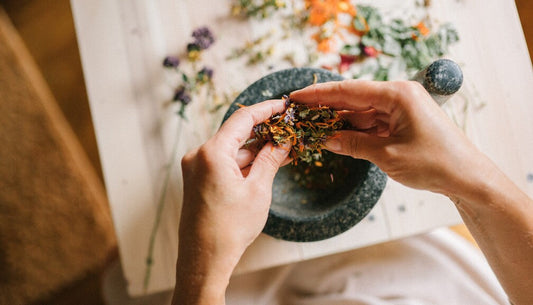We all need some Kapha dosha in our constitution. It provides stability, strength, and structure to the body and grounding energy to the mind. When in balance, Kapha types have sturdy builds, good stamina, regular digestion, and a tranquil personality. Even-tempered, patient, and kind, Kapha types power through the stresses of everyday life with ease and grace.
Excess Kapha dosha can slow you down, though, resulting in lethargy, obesity, apathy, and depression. Digestion lags, allergies and respiratory problems may arise, and Kaphas can become stubborn and resistant to change. Kapha energy is heavy, cold, moist, and dense by nature, and it requires stimulation to stay mobile and balanced.
So, if your primary dosha is Kapha or you are suffering from Kapha imbalance, keep your life active and interesting for all five senses. You will thrive on sunny days, balmy breezes, and food that is warm, light, and spicy. Surround yourself with shades of red and orange and invigorating aromas such as clove, eucalyptus, and rosemary. Listen to lively, upbeat music, and exercise regularly, especially participating in endurance activities such as running, hiking, and cycling.
Along with diet and lifestyle changes, bodywork is a great way to keep Kapha energy from getting sluggish. The best treatments for Kaphas are warming, stimulating, purifying, and not too heavy in oil—making the following therapies ideal.
There are many treatments and activities that can be considered swedana in Ayurveda, but the spa version is usually administered after a full-body oiling or massage. A tent is placed over the treatment table, covering all but the head, and cold compresses are put on the forehead and heart to prevent overheating. Herbalized steam fills the tent, drawing out toxins through the sweat glands, generally for up to about 20 minutes.
It reduces feelings of heaviness and stiffness in the body, increases circulation, improves digestion, and eases aching joints and muscles. If you can’t get to the spa for the full treatment, try a sauna or steam room for similar effects.
The benefits for Kaphas include improved skin tone and clarity, increased circulation and metabolism, and lessening of the appearance of cellulite. When followed by swedana, it is a powerhouse purifying therapy.
Neti is often followed by nasya, which is the application of oil to the sinus passages. Using a dropper, cotton swab, or finger, apply a few drops of oil to the inside of your nostril and inhale into your sinuses. It soothes and protects sinus membranes and helps keep congestion-prone Kaphas breathing easier.
Excess Kapha dosha can slow you down, though, resulting in lethargy, obesity, apathy, and depression. Digestion lags, allergies and respiratory problems may arise, and Kaphas can become stubborn and resistant to change. Kapha energy is heavy, cold, moist, and dense by nature, and it requires stimulation to stay mobile and balanced.
So, if your primary dosha is Kapha or you are suffering from Kapha imbalance, keep your life active and interesting for all five senses. You will thrive on sunny days, balmy breezes, and food that is warm, light, and spicy. Surround yourself with shades of red and orange and invigorating aromas such as clove, eucalyptus, and rosemary. Listen to lively, upbeat music, and exercise regularly, especially participating in endurance activities such as running, hiking, and cycling.
Along with diet and lifestyle changes, bodywork is a great way to keep Kapha energy from getting sluggish. The best treatments for Kaphas are warming, stimulating, purifying, and not too heavy in oil—making the following therapies ideal.
Garshana
There is no oil used at all in garshana. It is a dry, brisk, and rhythmic massage, usually done with cotton, silk, or wool gloves, or alternatively with a soft-bristled body brush. It helps the body detoxify by gently exfoliating the skin and stimulating the circulation of blood and lymph. Best of all, it’s easy to do at home, and is especially beneficial before bathing or abhyanga massage. Add it to your morning routine for best results.Vishesh
Because of their strong, dense musculature, Kapha types often prefer deep-tissue massage. Vishesh is another rhythmic massage technique, using firm, slow strokes to elongate contracted muscles, break up adhesions, and help release deep-seated impurities. Very little oil is used, or if it follows abhyanga massage, most surface oil is removed. This allows for a high level of friction on the skin and deeper access to the tissues. Afterward, Kaphas feel light, loose, and relaxed.Swedana
Kaphas generally don’t like the cold, and swedana is a great way for them to warm up and detoxify. The name swedana comes from the Sanskrit word for perspiration, and inducing a sweat is the key to its many benefits.There are many treatments and activities that can be considered swedana in Ayurveda, but the spa version is usually administered after a full-body oiling or massage. A tent is placed over the treatment table, covering all but the head, and cold compresses are put on the forehead and heart to prevent overheating. Herbalized steam fills the tent, drawing out toxins through the sweat glands, generally for up to about 20 minutes.
It reduces feelings of heaviness and stiffness in the body, increases circulation, improves digestion, and eases aching joints and muscles. If you can’t get to the spa for the full treatment, try a sauna or steam room for similar effects.
Udvartana
Often recommended for issues of slow metabolism and obesity, udvartana is an invigorating and exfoliating lymphatic massage using a paste made from oil, powders, and finely ground herbs. The paste is applied to the body with rhythmic upward strokes to encourage the flow of lymph to the heart.The benefits for Kaphas include improved skin tone and clarity, increased circulation and metabolism, and lessening of the appearance of cellulite. When followed by swedana, it is a powerhouse purifying therapy.
Neti
You don’t need a spa for this easy treatment—just a neti pot, purified water, and sea salt. Kaphas can be prone to congestion, and neti—the practice of flushing the sinuses with warm salt water—is a great way to keep them clear. It helps alleviate sinus pain and pressure, thins nasal discharge, loosens and removes irritants, and helps prevent and heal upper respiratory infections. Follow these detailed directions on how to use a neti pot.Neti is often followed by nasya, which is the application of oil to the sinus passages. Using a dropper, cotton swab, or finger, apply a few drops of oil to the inside of your nostril and inhale into your sinuses. It soothes and protects sinus membranes and helps keep congestion-prone Kaphas breathing easier.






















